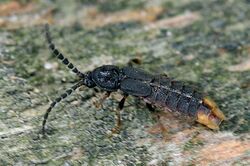Biology:Phosphaenus hemipterus
| Phosphaenus hemipterus | |
|---|---|

| |
| Scientific classification | |
| Kingdom: | |
| Phylum: | |
| Class: | |
| Order: | |
| Family: | |
| Genus: | |
| Species: | P. hemipterus
|
| Binomial name | |
| Phosphaenus hemipterus (Goeze, 1777)
| |
Phosphaenus hemipterus, the short-winged firefly or lesser glow worm, is a beetle of the family Lampyridae. It is found in the Mediterranean, in Central Europe, west to the Atlantic Ocean and north to the edge of Scandinavia and in England. In North America, the species has been introduced. It inhabits meadows, floodplains, forest edges, and dry slopes, but also parks and gardens. In Britain, this species is fairly rare compared to its cousin the common glow-worm (Lampyris noctiluca).
The larvae are similar to the larvae of Lampyris noctiluca, but they lack the bilateral series of reddish dots on the abdomen, and they are a little darker and brighter colored, slender in build and smaller.
The beetles have a body length of 6–8 millimetres (0.24–0.31 in) (males) 10 mm (0.39 in) (females). The body is dark brown and has a reddish tinge. The males have greatly shortened wing covers and unlike other fireflies are similar to the female. Their membranous wings are reduced, which is why they resemble the flightless females.
References
Wikidata ☰ Q477797 entry

